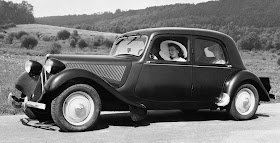Bertoni was a sculptor as well as a car stylist, which might not have been a bad thing in theory. In the days before computer assisted design, stylists usually sketched themes. And those sketches were often exaggerated to the point that the intended effect was lost when a model of it conforming to dimensions of a usable car was built. This problem was largely eliminated when stylist relied on sculpting in the first place. On the other hand, the sculpting approach has been criticized because actual cars are more like semi-hollow shells with windows rather than being solid lumps. So sculpting also can present a distorted version of an actual car.
Bertoni was responsible for the design of Citroën's major models from the 1930s until the early 1960s, the time of his comparatively early death. Here are those cars:
Gallery
Traction Avant (from 1934)
The Traction Avant (front wheel drive) was radical in its day. Thanks to its drive train, the passenger compartment could be set lower to the ground and its center of gravity lowered to improve roadability. Other front wheel drive cars existed in the mid-1930s, but Citroën's version was the only one to attain high production volumes (for Europe in those days).
Prototype 2CV (c.1939)
Mass-production versions of the iconic Citroën 2CV (two "steam horsepower") had two headlamps and were otherwise tidied-up versions of the extremely basic prototype shown here. Although Bertoni gets the credit for "styling" the 2CV, it was so minimal and intended to be cheap to build, that engineer André Lefèbvre (1894-1964) might instead be considered the designer.
DS 19 - 1956
The DS was a sensation when it was first displayed at the Paris auto show in the fall of 1955. This was largely due to engineering features, though its unusual styling also attracted much attention. That styling was far removed from anything the Italians, Germans and Americans were doing at the time -- or since.
Ami 6 - 1961
The Ami was Bertoni's final Citroën design. A distinctive feature was its reverse-slope back window, an element that had been used earlier by other brands, including Mercury.
I find it a little difficult to evaluate Bertoni's designs because they were so far from mainstream thinking in Europe as well as America, and because they mostly were tied to unusual engineering solutions.
Let's just say that Bertoni was creative.
But what about the aesthetics? Did his designs look good?
I happen to like the Traction Avant styling best. To be sure, it was of its early 1930s time, yet it was racier looking than much of its mass-production competition.
As noted above, the 2CV was largely an engineering-based design, so its appearance wins points for functionality even though it's pretty ugly.
The DS is harder for me to pin down. I can appreciate it intellectually, but was never fond of the styling. The defects are related to what stylists call the "greenhouse," the windows-and-roof area. To me, it always seemed too spindly, insubstantial -- that due to the thin door posts. At a more general level, this wispy upper area contrasted too greatly with the rather thick, heavy lower body, thereby destroying unity of the whole. The brake lights at the rear of the roof also struck me as being too contrived a solution to a fairly minor potential problem.
And the Ami? I think it is an ugly mess.




The DS lights at the top of the roof aren't break lights, they are the turn signals.
ReplyDelete